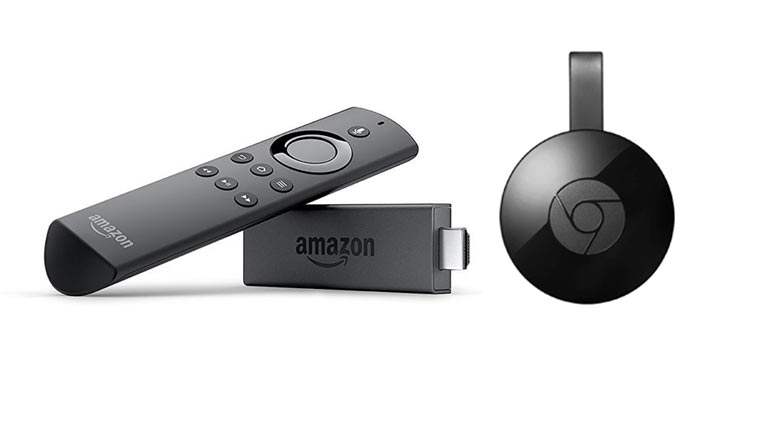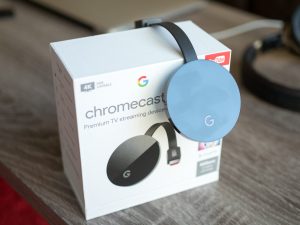Chromecast vs. Fire TV: What's the Difference?

Appeared here a few months ago TechnikNews my test report on the Fire TV Stick from Amazon. Since I now also have a Chromecast in the house, I can now show the differences between these two devices.
Jump to section
Available options
Let's start with the most basic thing, which is the choice of equipment. With the Chromecast you can choose between a normal model and the Chromecast Ultra. The normal Chromecast can play videos up to 1080p via WiFi and without HDR. In terms of price, this is at an RRP of € 40. The Chromecast Ultra can play videos up to 4K, but it also costs 80 €. In return, this device also supports HDR and Ethernet, the connector of which is located directly on the power supply unit.
There are also two models of Fire TV that will suit most people. The Fire TV Stick, comparable to the normal Chromecast, can also play videos up to 1080p via WiFi and without HDR. In terms of price, it is on par with the Chromecast at € 40. The Fire TV with 4K, on the other hand, can be compared with the Chromecast Ultra. With a maximum resolution of up to 4K for playback via WiFi with HDR, we're talking about the same options that you have with the Chromecast Ultra. What is different here, however, is that you have to buy an extra Ethernet adapter for around 15 €, it is not included in the scope of delivery as standard. In addition there is the 80 € for the device itself.
Design
In terms of design, the entry-level models of the two companies couldn't be more different. The Fire TV Stick is, as the name suggests, an elongated stick with an HDMI connection on one side that goes into the television. The device receives power via a micro USB connector on the side, on the top there is only the Amazon logo. The Chromecast, on the other hand, looks like a kind of puck with an HDMI cable sticking out. It gets power via the micro USB port on the side. The Chrome logo is on the matte top.
However, there is a certain similarity in design between the two more expensive models, with both the HDMI connector protruding from a ribbon cable. The Fire TV with 4K has a square shape, the Chromecast Ultra retains the round shape of the older model with 1080p. However, it looks more minimalist in my eyes, as the surface is reflective instead of matt. The two models around 80 € have, like the cheaper devices, a micro USB connector on the side. USB-C is not yet used here.
Control and setup
Many people are now asking themselves how to set up these streaming sticks and how to use them. To set up the Chromecasts you need an Android or iOS device and the Google Home app from the App Store or the Play Store. There you give the Chromecast access to its Google account and connect it to the WLAN. Then there are a few more data protection declarations, done.
For the actual control you only need your smartphone or tablet. It is also possible to operate the device with a Google Home Speaker, there is no remote control. Many do not know that the two models can also be controlled via the Chrome browser on the PC or laptop. In order to be able to play media, the desired service must support Google Cast. This can be recognized by the fact that the Cast symbol appears in an app when the end device is in the same WLAN as the Chromecast. Further control options for playback also appear on the smartphone or tablet.
The Fire TVs are set up directly on the device itself, where it is similar to that of the Chromecasts. A disadvantage here, however, is that you have to enter passwords and login data via the Alexa voice remote control. The remote app for Android and iOS with the keyboard can only be used once the setup has been completed.
Once set up, you can use the remote control, a speaker that houses Alexa or, as mentioned above, the remote app. Theoretically, you can address apps like Netflix via Google Cast, but this doesn't work in practice. A nice bonus: supported smart home devices can also be controlled with the voice remote control. All in all, from my point of view, the controls here are easier and more pleasant than with the Chromecast.
Range of apps
The range of apps is mostly identical in both cases, apps like Netflix, Zattoo, PRO7 or ZDF are available for both platforms. Unfortunately, you can't say that about Prime Video on YouTube. Due to a dispute between Amazon and Google, both apps disappeared from the other device. Fortunately, there is a workaround for the Fire TVs that allows you to still enjoy YouTube: You can easily surf the YouTube website via Firefox or Silk. There you get a similar experience as with the video service app that was once available.
Operating system
The Chromecasts both have no real operating system. The only thing there is is a start page with a slide show, where the time and some other information are also displayed. This was made possible by the fact that all apps are started with the mobile phone, tablet or Google Home, so no menus were necessary.
The operating system of the Fire TVs is based on Android and is called Fire OS. This consists of many menus with several tabs and tiles, one is also often covered with advertising for content from Amazon itself. At first, the UI may be confusing for some, but you get used to it quickly.
Summary
Ultimately, there are two factors that should be considered when making a purchase decision. The first: do I have a 4K television that, in the best case scenario, also supports HDR? If so, I would immediately go for one of the two 4K models. Otherwise, the two alternatives are completely sufficient.
The second factor: do I use Prime Video from Amazon? If so, grab one of the Fire TVs immediately, as they also support YouTube via the browser. Otherwise the Chromecasts are enough.


